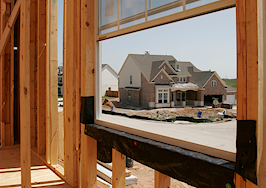This report is available exclusively to subscribers of Inman Intel, a data and research arm of Inman offering deep insights and market intelligence on the business of residential real estate and proptech. Subscribe today.
When the housing market exploded in 2021, real estate broker Ben Caballero was steering a business in decline.
If you can refer to a drop from $2.5 billion to just under $2 billion in sales volume as “in decline,” that is.
Caballero is known as the nation’s perennial No. 1 real estate broker by sales volume because of his platform HomesUSA, which assists some of the nation’s biggest homebuilders in listing their inventory on the MLS. And despite the drop in 2021, it wasn’t even a close competition. The second-place broker accounted for just under $1.2 billion in volume, according to RealTrends.
As a broker with a longtime background in homebuilding, Caballero has his finger on the pulse of the entire real estate transaction market. He spoke with Intel by video chat to share how he built his enormous platform, as well as what he’s seeing transpire across the industry.
His comments below have been edited for length and clarity.
Intel: I understand your background before this was in homebuilding. How did you first realize there was such a large opportunity here working with homebuilders in this way?
Caballero: Well, I got my broker’s license when I was 21, and I was always in the real estate business. I started in the apartment rental [side] and so forth. I built a few apartments and then morphed into custom homebuilding. And when I did that, I started using MLS because I was a Realtor. And I saw that it was very helpful. At that time, there weren’t a lot of builders doing that. They didn’t really see the value.
But as I furthered my career, I got out of homebuilding and started another builder-related business and continued to develop the multiple listing service (MLS). And then, of course, the big change came when computers became more available, and so 2005, 2007, builders started putting computers in their sales offices. So that’s when we developed our platform and have been able to increase its value and ease of use and efficiency in that time.
How were you able to grow your business so much bigger than, say, other people in the same space?
Because we have something that Realtors don’t have. One of my major clients, they said hardly a day goes by that they don’t get contacted by an agent wanting to list their homes. And their standard answer is, ‘Well, if you can come up with something comparable to HomesUSA, let me know and then we’ll talk.’
But on your way up, as you were trying to communicate this to homebuilders, how did you make that case, get through to them and gain market share?
I had been in the building business [and] had other building-related ventures, and so I knew people in the business. And I took the sales manager for Lennar out to lunch one time — we’d known each other for a long time — and I said, ‘Let me list your homes on the MLS.’ And he said, ‘Oh, Ben, we don’t need that. We’re doing just fine.’ And I said, ‘Let me list your homes for 60 days and if you find that it’s not worthwhile, just don’t pay me anything.’ He’s a friend, and he said OK. I made him a deal he couldn’t refuse — no loss.
So we did that and it just took off. We never looked back. He listed a couple thousand homes that year, and Lennar [is a] big builder, been a big builder for a long time. So I just capitalized on my contacts and performance. Builders, once they saw what we were doing, they really saw the value and the need. But it was a breakthrough, because as I said, builders weren’t really — they didn’t see the benefits and they were not wanting to pay maybe the 3 percent if they could avoid it. Some builders would work with Realtors, and when times were good, they would say, ‘No, we don’t really want to work with you anymore. They would turn them on, turn them off. But builders have come a long way. They realize now that MLS and Realtors are an integral part of their success, and there’s a new appreciation, I think, for both sides.
Tell us about the actual HomesUSA operation: What’s the day-to-day look like when you’re processing maybe 15-plus transactions?
Well, let’s see. Monday, I think we did 484 requests. So that tells you the level of service that we do, because I think we might have listed 26 homes that day: New listings. But there are a lot of changes that go on with a new home. They typically list them in mid-construction. So we’re having to update the completion dates, and when it is complete, we need to do that.
Builders, they raise their prices, lower their prices, depending on whatever their inventory is and the market conditions. We average about 23 changes per listing during the life of the listing. And so it’s not just listing the homes and closing them out when they sell.
Is it a pretty sizable staff that needs to be involved in that, or is a lot done just through the platform that has already been built?
Everything is done through the platform. We collect the data through the platform. We don’t accept emails or telephone calls or anything. It has to be requested through our system because then we can track when it was received, when we uploaded it. And so there’s an audit trail, so to speak, that builders can see how long it’s taking. We average about 13 minutes to process a request — a new listing or a change.
I guess our staff’s about 10 people that actually are involved in the processing and so forth. And more than that, we have probably 12 or 13 people that are doing the IT support. And then of course we have our administrative staff. So approximately 30 people in our company right now.
I think it’s interesting the place you occupy within the industry, working with homebuilders so closely. Obviously, they’ve seen some rough months in terms of sales in recent months. How has this new environment for homebuilders affected your business?
I’m amazed at the resilience of the homebuilding industry. In the third week of April last year, up until that time, our business was pretty slow because builders were able to sell from a waiting list. They had too many buyers. Their problem was just managing the buyers, because their production could not keep up with the demand. They didn’t need to list their homes as much.
But when the interest rates went up, it caused all the cancelations. Plus the builders had their machine going, and you know, it takes a number of months — 6 to 8 months — from the time that you say, well, I’m going to build a home on this lot, to the time that you deliver that. So they had homes in that process that they were anticipating sales to continue, and they were ramping up their production.
So in addition to the cancelations, that really caused a ramp-up in inventory, and so they really had to change their tune. They became more aggressive in selling. They started doing more promotions in terms of buyer incentives and Realtor bonuses. So we had our best month I think in May or June of last year in our history because of all the increased inventory. Does that address your question?
It does. And how do you think things are shaping up now that we’re into the spring of this year?
We’re in a seasonal upward trend. Sales are always good in the first three to six months of the year, so we have that. Plus, they have reduced their inventory. Sales are picking up. Prices have stabilized. It’ll be interesting to see what happens in the last six months of the year, and of course that’s going to depend on interest rates.
But I had lunch with a builder last Thursday, I think it was, and they were telling me that they were having some problems with supply lines again and with labor. Homes are essentially handmade mostly, and so they are experiencing issues there. Again, they’re resilient, they’ll overcome it. They will adjust and be OK. The prices have come down, but they are stabilized.
Do you have a general expectation for what demand for new homes would look like in the coming months — how long they would take to recover to roughly normal levels? That’s one of the things we’re trying to keep our eye on in the homebuilding space.
In the states with no income tax like Tennessee, Florida and Texas, they’re going to do fairly well. They’re going to do better than the rest of the country by far. I think large states like California and Illinois [and] the Northeast, they’re going to struggle. These other states are going to have the demand, and the demand is going to keep the prices more stable. They’re not going to suffer as much.
With that said, we’re looking at a market that’s going to be depending on the growth of the states that they’re in. I think Texas and Florida and Tennessee and a few other states are going to do OK.
Are there any market metrics you follow closely from month to month that give you a sense of where things might be heading? What should other executives be paying attention to that you keep a close eye on?
We do a monthly Texas index, new home index. We track six metrics: Sales price, sales price as a percentage of list, pendings, actives and the months of inventory. Those are available to our clients. One interesting thing that I thought might be of interest to you: We track not only new homes but pre-owned homes. And the prices of new homes from their peak to their low dropped about 3 percent, while pre-owned homes dropped about 8 percent. That’s what the numbers say.
But the story behind the numbers is that builders have been able to mitigate their price reductions through the ability to offer incentives and bonuses. They can do [mortgage rate] buy-downs. They can pay closing costs. They can add upgrades to their homes, so all these are very positive [steps] for new homes that pre-owned homes can’t do.
Builders are resilient. As a builder for 18 years, I realize how difficult it is. You’re dependent on the weather, you’re dependent on interest rates, you’re dependent on trades and supplies. Just how long it takes to get a building permit, which takes as long as 90 days sometimes. All the time, you’re paying interest on that lot.
So a company like D.R. Horton and Lennar that lead the country leaders, for them to do that is just amazing to me. And these production builders, all of them are pretty amazing, as far as I’m concerned, in what they’re able to accomplish.













